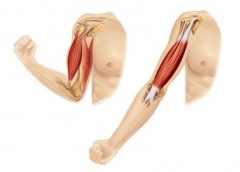Static contraction
Remember, there is nothing sacred about conventional training. If unconventional methods get you there faster, use them.
As you get stronger, you need to exercise less - it's a biological law.
Many of the test subjects made such rapid progress that they soon exhausted the limits of their training equipment.
Some had to switch to one-armed lat pulling to double the load.
We set up the study of static contraction to answer the following questions about static contraction training:
- Does it lead to an increase in muscle mass?
- Does it lead to a reduction in body fat?
- Does it lead to an increase in muscle size?
- Does it lead to an increase in both static and dynamic (full radius) force?
These answers are important to bodybuilders because they concern actual benefits, which is not the case with most of the parameters measured in the few strength studies.
At the beginning of the study, we recorded the following data for all test subjects: age, weight, body fat percentage, as well as chest, waist, shoulder, biceps, forearm, wrist, thigh and calf measurements.
As a next step, the following strength values were determined for 17 specific exercises:
1) 1-WH-Maxi-mum, conventional design, full radius
2) 10 WH maxi mum. conventional design, full radius
3) 15 seconds of static holding of a maximum possible weight in the strongest position, that is, a weight that is heavy enough that the subject cannot hold it for more than 15 seconds, after which it begins to sink.

The training program consisted of 10 compound exercises, which were spread over two training units of five exercises each, carried out on different days.
Let's take the bench press as an example to demonstrate how static hold worked.
The test subjects lifted the weight from the resting point, which was at the upper end of the reach of their arms, lowered it from the fully stretched position about five to seven centimeters - the strongest area - and held it here without any upward or downward movement Static movement in the air.
In the subsequent training units, the subjects increased their intensity by holding the weight statically for a longer period of time, for example 21 seconds up to 30 seconds. As soon as they could hold a certain weight for 30 seconds, it was increased.
Particularly noteworthy is the extremely short overall training duration. With one set per exercise, training session i (five exercises) lasted no more than 75 seconds to 2 1/2 minutes in total. Just imagine a complete training session in just 2 1/2 minutes. ‘Of course, a little extra time was lost in adjusting the weights, taking breaks between sets, etc.
What is certain is that measured against the extremely short duration of the maximum muscle contraction, the intensity was extremely high. You just have to try this type of training to fully appreciate its quality.
TRAINIGSHÄUFIGKEIT
Extensive knowledge on the topic of training frequency could be gathered. At the start of the study, a group was required to exercise three days per week. About three weeks after the start of the study, the subjects complained of classic symptoms of overtraining, and some were even unable to continue. Their training plans had to be changed due to the heavier weights they were forced to lift as they increased their strength.
Growth and regeneration are systemic phenomena, and the stronger your muscles get, the longer it takes for the supporting organs to remove the waste products created by exercise.
The fact that these twelve experienced bodybuilders with an average age of 38.4 years achieved such fantastic gains in mass, strength and muscle size in just 10 weeks of training is likely to be unique in training physiology.
That they did this with zero range of motion is without question unique. In addition, it was proven that, contrary to popular belief, static contraction training significantly improves dynamic strength over a full range of motion and that the range of motion does not play a role in terms of new muscle growth, improved strength and / or muscle size.
Static Contraction - THE TEST PERSONS
How did we work with male volunteer test persons from our customer database. Most of them were long-time bodybuilders who said of themselves that they had almost exhausted their muscle potential. In any case, it was more difficult for these men to regain muscle growth than for the average person.
Static Contraction - THE EVALUATION
Both static strength and dynamic strength (full range of motion), lean muscle mass and muscle size could be fundamentally advanced. The fact is that all subjects without a single exception - improved their strength level. The average static strength, measured in 17 exercises, increased by 51.3 percent, and that should be a huge surprise for almost everyone - the dynamic strength over a conventional full range of motion was also increased.
Joaquin M., for example, built up a whopping 13 kilos of new muscle mass with no range of motion.
The fact is, you can achieve fundamental gains without movement (static contraction), with some movement (partial repetitions), and with full repetitions (conventional training).
So the range of motion does not matter.

Static Contraction - Conclusion
Many of the test subjects made such rapid progress that they soon exhausted the limits of their training equipment.
Some had to switch to one-armed lat pulling to double the load.
The increases in mass and muscle size exhibited by these subjects speak volumes. Bodybuilders who strive for more mass and muscle size shouldn't really care how they achieve their goal!

2 comments
Comments are closed.